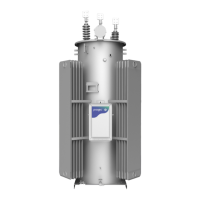GEH-7299A: Installation, Operation and Maintenance Manual
for Type VR1™ Single-Phase, Step Type Regulators
prolec.energy/prolecge
24
Caution: Exposure to atmosphere is occasionally necessary to untank regulators for maintenance. The following rules must
be applied.
1. Internal assemblies may be exposed to the atmostphere for a maximim of eight hours without requiring re-baking.
2. Internal assemblies exposed to the atmostphere for more than eight hours must be re-baked for a minimum of 14
hours at 110°C.
3.
4. No more than two re-bakes should be allowed in any event. Total re-bakes time should never exceed 32 hours at
110°C.
5.
Figure 13. Recommended Un-tanking Type VR-1 Step Voltage Regulator,
showing use of Tank Spreader Bar when lifting Interior & Cover.
Cover Connections
Spreader Bar (or plate spreader option)
5.2 Untanking
Warning: De-energize the regulator before untanking.
Warning: To avoid possible injury, pull ring on pressure relief to equalize internal tank pressure before attempting to
remove tank cover or handhole cover.
To untank the regulator, proceed as follows:
1. Release the internal pressure using the pull-ring on the pressure relief and remove the cover band.
2. Remove the bolts holding the control housing support to the tank wall. They are located just below the control
housing.
3. Lift the cover-suspended regulator from tank, using the lifting eyes on the top of the cover. The use of a spreader bar
is recommended. See Figure 13.
After untanking the regulator, the switch mechanism can be operated through the control circuit.
Warning: Before applying power to operate the mechanism, short-circuit and ground the bushings as a safeguard against
dangerous voltages from accidental excitation of the high voltage windings.

